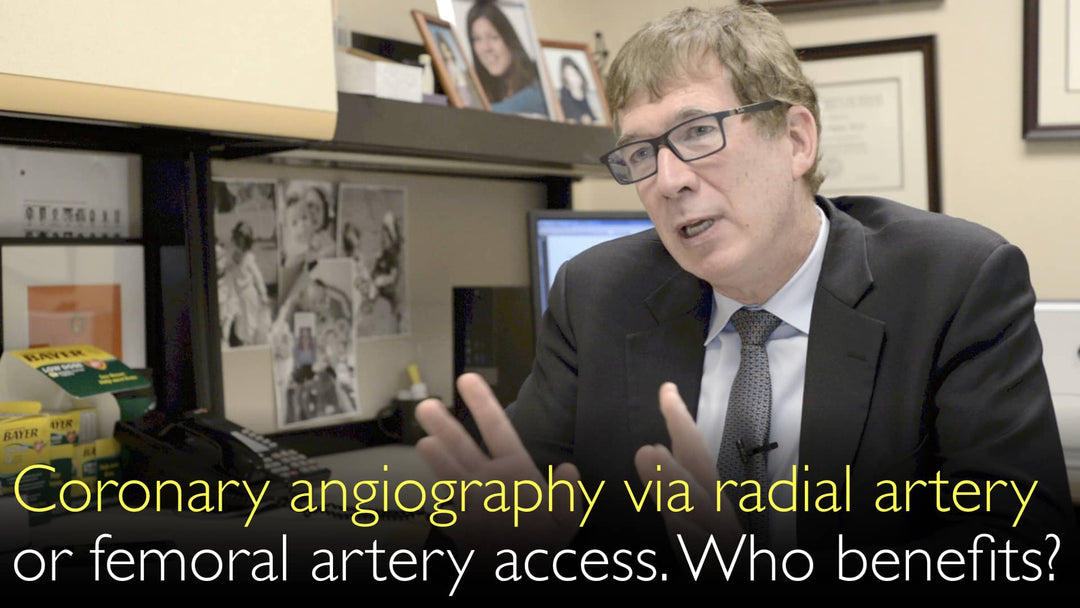Leading expert in minimally invasive coronary interventions, Dr. Jeffrey Popma, MD, explains the benefits of radial artery access for coronary angiography. He details how this approach improves patient recovery and reduces bleeding complications. Dr. Popma also outlines the specific clinical scenarios where the traditional femoral artery approach remains necessary. Dr. Jeffrey Popma, MD, shares adoption rates and patient outcomes from his high-volume center.
Radial vs Femoral Artery Access for Coronary Angiography: A Clinical Guide
Jump To Section
- Radial Approach Benefits
- Patient Recovery Advantages
- Bleeding Complication Reduction
- Clinical Adoption Rates
- Femoral Approach Indications
- Anatomical Challenges
- Full Transcript
Radial Approach Benefits
Dr. Jeffrey Popma, MD, a leading interventional cardiologist, champions the radial artery approach for coronary angiography. He explains that this method has become the preferred technique at his institution. The shift began approximately seven years ago and was driven by significant patient benefits.
Dr. Jeffrey Popma, MD, notes that radial access allows for more rapid procedures in certain cases, such as facilitating thrombus lysis. The technique provides excellent visualization of the coronary arteries, which is critical for accurate diagnosis before procedures like bypass surgery or percutaneous interventions.
Patient Recovery Advantages
A major advantage of radial artery coronary angiography is enhanced patient recovery. Dr. Jeffrey Popma, MD, emphasizes that patients report a much better experience with this approach. They recover more quickly and can return to normal activity sooner after the procedure.
This improved recovery profile directly enables same-day discharge for many patients undergoing percutaneous coronary interventions. Dr. Anton Titov, MD, discusses this benefit, highlighting how it increases patient satisfaction and reduces hospital resource utilization.
Bleeding Complication Reduction
Radial access significantly reduces bleeding complications compared to the femoral approach. Dr. Jeffrey Popma, MD, identifies this as a critical safety benefit. The radial artery's superficial location allows for better compression and hemostasis after catheter removal.
This reduced bleeding risk is particularly important for patients on anticoagulant or antiplatelet medications. The safety profile makes radial artery coronary angiography suitable for a broader range of patients, including those with higher bleeding risks.
Clinical Adoption Rates
Dr. Jeffrey Popma, MD, reports impressive adoption rates for radial access at his institution. His team now performs 80% to 90% of coronary angiograms via the radial approach. This high utilization rate reflects both physician proficiency and patient preference.
All practitioners at his center have embraced this technique, becoming what he describes as "radialists." This widespread adoption demonstrates how radial artery coronary angiography has become the standard of care in modern interventional cardiology practice.
Femoral Approach Indications
Despite the advantages of radial access, the femoral approach remains necessary in specific cases. Dr. Jeffrey Popma, MD, explains that approximately 10% of patients require femoral artery access for coronary angiography. These are typically patients with challenging anatomy that prevents successful radial access.
Dr. Anton Titov, MD, explores these clinical scenarios with Dr. Jeffrey Popma, MD. The femoral approach provides an essential alternative when radial access proves technically difficult or impossible to achieve safely.
Anatomical Challenges
Several anatomical factors can preclude radial artery access for coronary angiography. Dr. Jeffrey Popma, MD, describes patients with very small radial arteries that cannot accommodate catheters. Other patients exhibit tortuous radial artery anatomy before reaching the shoulder region.
Complex subclavian artery anatomy or difficult access into the aorta can also prevent successful coronary cannulation via radial approach. In these situations, Dr. Popma confirms that femoral artery access becomes the necessary and preferred alternative for completing the diagnostic coronary angiogram.
Full Transcript
Dr. Anton Titov, MD: When is the femoral artery used instead of the radial artery for coronary angiography? A leading coronary artery minimally invasive intervention cardiologist explains.
Coronary artery angiography is used to assess patients prior to coronary artery bypass grafting surgery.
Coronary artery angiogram is also used before percutaneous coronary artery procedures.
Sometimes patients could benefit from a radial artery approach in coronary artery angiography. Is it preferred over the classical femoral approach?
You are particularly interested in this. You are an international expert in the radial approach coronary artery angiography.
Dr. Jeffrey Popma, MD: I have to say that all of our practitioners here at the Beth Israel Deaconess Hospital are "radialists". This probably happened about seven years ago or so.
Then a couple of interventional cardiologists started to use the radial artery approach in coronary angiography. We found that the patients liked it better.
They recovered quicker, patients were more active, the bleeding complications were less.
We became proficient in terms of gaining access to the coronaries and taking pictures. Today we are in the 80% to 90% range for radial artery access coronary angiography.
With all our practitioners here, all the doctors here do that. For us it allowed more rapid thrombus lysis.
Radial artery coronary angiography allows the same-day discharge after percutaneous interventions. It has been much better.
But there are some patients that have very small radial arteries. Some radial arteries have tortuosity of the radial artery before it gets up to the shoulder.
Or they have the access of the subclavian artery into the aorta, which makes it very difficult to then engage and cannulate the coronary arteries.
It is a rare patient, one in ten times or so. Rarely patients have unusual artery anatomy.
Then we would use the femoral artery approach in those patients. This is how we do coronary artery angiography.







